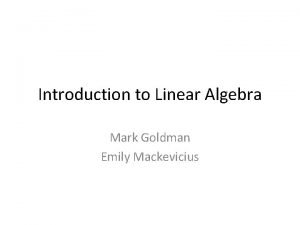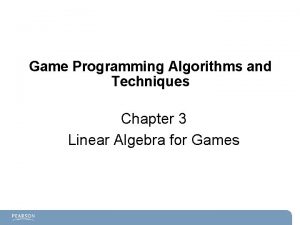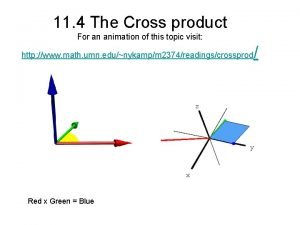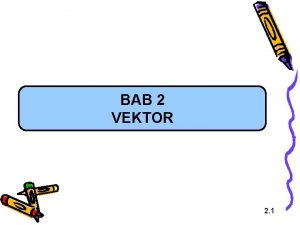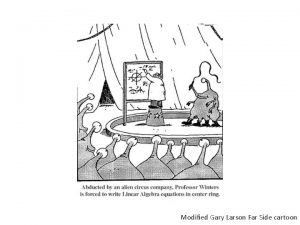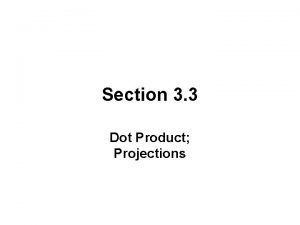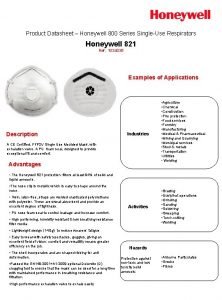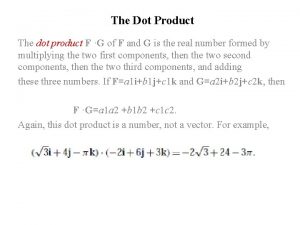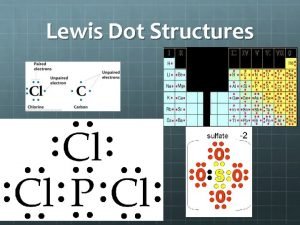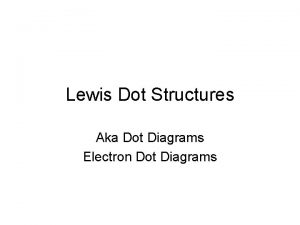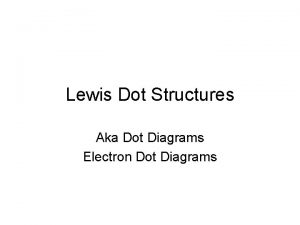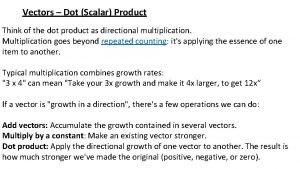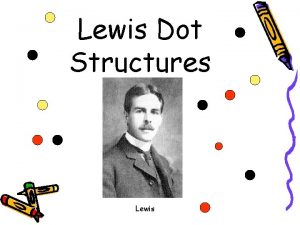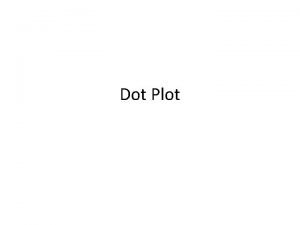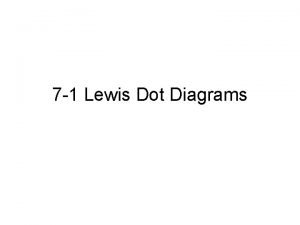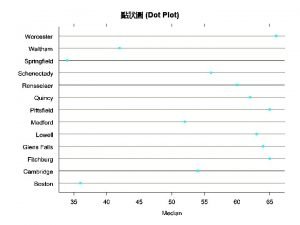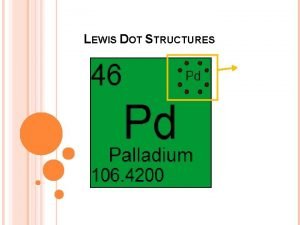12 3 The Dot Product The Dot Product


























- Slides: 26

12. 3 The Dot Product

The Dot Product To find the dot product of two vectors a and b, we multiply corresponding components and add together. The result is not a vector. It is a real number: A scalar. For this reason, the dot product is sometimes called the scalar product (or inner product). 2


Properties of the Dot Product The dot product obeys many of the laws that hold for ordinary products of real numbers. Theorem: 4

Geometric interpretation The dot product a b can be given a geometric interpretation in terms of the angle between a and b, where 0 . Figure 1 5

Example 2 If the vectors a and b have lengths 4 and 6, and the angle between them is /3, find a b. Solution: Using Theorem 3, we have a b = |a| |b| cos( /3) =4 6 = 12 6

The Dot Product The formula in Theorem 3 enables us to find the angle between two vectors: 7

Example 3 Find the angle between the vectors a = 2, 2, – 1 and b = 5, – 3, 2. Solution: Since: And: Then: a b = 2(5) + 2(– 3) + (– 1)(2) = 2 8

Dot Product of perpendicular vectors is zero! Two nonzero vectors a and b are called perpendicular or orthogonal if the angle between them is = /2. Then Theorem 3 gives: a b = | a | | b | cos( /2) = 0 and conversely if a b = 0, then cos = 0, so = /2. Therefore we have the following method for determining whether two vectors are orthogonal. 9

Example 4 Show that 2 i + 2 j – k is perpendicular to 5 i – 4 j + 2 k. Solution: Since (2 i + 2 j – k) (5 i – 4 j + 2 k) = 2(5) + 2(– 4) + (– 1)(2) = 0 these vectors are perpendicular. 10

Dot Product of parallel vectors In the extreme case where a and b point in exactly the same direction, we have = 0, so cos = 1 and a b=|a||b| If a and b point in exactly opposite directions, then = and so cos = – 1 and a b = –| a | | b |. 11

Direction Angles and Direction Cosines 12

Direction Angles Definition: The direction angles of a nonzero vector a are the angles , , and (in the interval [0, ]) that the vector makes with the positive x-, y-, and z-axes: 13

Direction Cosines The cosines of these direction angles, cos , and cos , are called the direction cosines of the vector a. Using: and replacing b by i, we obtain: Similarly, we also have 14

Direction Angles and Direction Cosines By squaring the expressions in Equations 8 and 9 and adding, we see that cos 2 + cos 2 = 1 We can also use Equations 8 and 9 to write: a = a 1, a 2, a 3 = |a| cos , |a| cos = |a| cos , cos Therefore: which says that the direction cosines of a are the components of the unit vector in the direction of a. 15

Example 5 Find the direction angles of the vector a = 1, 2, 3. Solution: Since Equations 8 and 9 give: and so 16

Projections 17

Projections PQ and PR are two vectors a and b with the same initial point P. If S is the foot of the perpendicular from R to PQ, then the vector PS is called the vector projection of b onto a and is denoted by proja b. (You can think of it as a shadow of b on a). Vector projections 18

Projections The scalar projection of b onto a (also called the component of b along a) is defined to be the signed magnitude of the vector projection, which is the number: | b | cos , where is the angle between a and b. Scalar projection 19

Projections Since: a b = | a | | b | cos = | a |(| b | cos ) Then we can say that compa , the component of b along a is the dot product of b with the unit vector in the direction of a: 20

Projections We summarize these ideas as follows. Notice that the vector projection is the scalar projection times the unit vector in the direction of a. 21

Example 6 Find the scalar projection and vector projection of b = 1, 1, 2 onto a = – 2, 3, 1 Solution: Since the scalar projection of b onto a is 22

Example 6 – Solution cont’d The vector projection is this scalar projection times the unit vector in the direction of a: 23

Application: Work of a force The work done by a constant force F in moving an object through a distance d is W = Fd, but this applies only when the force is parallel to the line of motion of the object. Suppose, however, that the constant force is a vector F = PR pointing in some other direction than the motion: 24

If the force moves the object from P to Q, then the displacement vector is D = PQ. The work done by this force is defined to be the product of the component of the force along D and the distance moved: W=F D W = (| F | cos ) | D | W = | F | | D | cos The work done by a constant force F is the dot product F D, where D is the displacement vector. 25

Practice example: A wagon is pulled a distance of 100 m along a horizontal path by a constant force of 70 N. The handle of the wagon is held at an angle of 35 above the horizontal. Find the work done by the force. Solution: If F and D are the force and displacement vectors, as pictured in Figure 7, then the work done is W =F D = | F | | D | cos 35 = (70)(100) cos 35 = 5734 J 26
 Id root
Id root Perbedaan cross product dan dot product
Perbedaan cross product dan dot product Dot product vs cross product
Dot product vs cross product Sifat cross product
Sifat cross product 1-5 solving inequalities
1-5 solving inequalities .net vs java
.net vs java Normal matrix
Normal matrix Lerp
Lerp Cross product animation
Cross product animation Chapter 12 vectors and the geometry of space solutions
Chapter 12 vectors and the geometry of space solutions Derivative of dot product
Derivative of dot product Dot product vektor satuan i.i adalah
Dot product vektor satuan i.i adalah Dot product
Dot product Vektor dot
Vektor dot What is the meaning of dot product
What is the meaning of dot product 8-5 dot and cross products of vectors in space
8-5 dot and cross products of vectors in space Hasil kali titik
Hasil kali titik Linear equation cartoon
Linear equation cartoon 8-3 dot products and vector projections
8-3 dot products and vector projections Homogeneous coordinates vs cartesian coordinates
Homogeneous coordinates vs cartesian coordinates Sifat cross product
Sifat cross product Dot product of matrix
Dot product of matrix How to determine theoretical yield
How to determine theoretical yield Dot product
Dot product Dot product intuition
Dot product intuition Dot product
Dot product Dot product
Dot product






